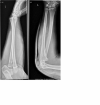An Unusual Case of Anterior Elbow Dislocation Without Bony Injury
- PMID: 33824806
- PMCID: PMC8016327
- DOI: 10.7759/cureus.13655
An Unusual Case of Anterior Elbow Dislocation Without Bony Injury
Abstract
While elbow dislocation is a common occurrence, the vast majority of them dislocate posteriorly and are due to disruption of the elbow stabilizers, which start on the lateral side and proceed medially, disrupting the anterior and posterior stabilizing structures. We present an unusual case of anterior elbow dislocation, with disruption of the medial stabilizing structures and anterior capsule, without any bony injury. A 44-year-old man presented to the ED after being assaulted. While the exact mechanism of injury was unclear, the patient believes he had been struck with a heavy object on the posterior aspect of his elbow. His dislocation was reduced in the ED, but was highly unstable after reduction. Further imaging revealed disruption of his medial collateral ligaments and common flexor origin. He went on to have an open repair of his medial structures with suture anchors. After six weeks of follow-up he was doing well, with no further episodes of instability and a good functional range of movement. Though rare, anterior elbow dislocations have been reported sporadically in the literature. Surgeons and ED doctors dealing with these injuries should be aware that the maneuvers to relocate the elbow will be different compared to the standard maneuvers used for posterior dislocations. Patients should be examined for stability after reduction, especially on valgus stressing. We would advocate for low threshold for performing an examination under anesthesia (EUA), with open repair of the stabilizing structures if persistently unstable after reduction.
Keywords: anterior elbow dislocation; instability; open reduction.
Copyright © 2021, Fahey et al.
Conflict of interest statement
The authors have declared that no competing interests exist.
Figures





References
-
- Incidence of elbow dislocations in the United States population. Stoneback JW, Owens BD, Sykes J, et al. J Bone Joint Surg. 2012;94:240–245. - PubMed
-
- Patient-reported outcomes after simple dislocation of the elbow. Anakwe RE, Middleton SD, Jenkins PJ, et al. J Bone Joint Surg. 2011;93:1220–1226. - PubMed
-
- Simple dislocation of the elbow in the adult. Results after closed treatment. Mehlhoff TL, Noble PC, Bennett JB, et al. https://pubmed.ncbi.nlm.nih.gov/3343270/ J Bone Joint Surg. 1988;70:244–249. - PubMed
Publication types
LinkOut - more resources
Full Text Sources
Other Literature Sources
